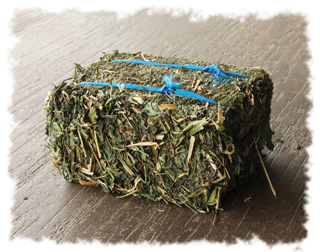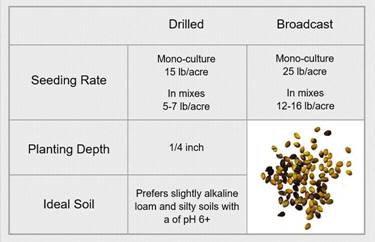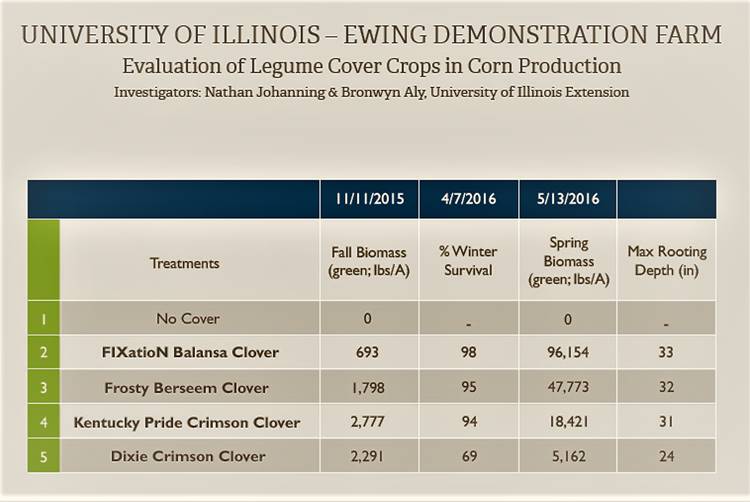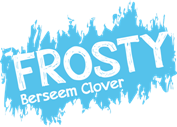Frost seeding of FROSTY CLOVER can be used by grazers as a means to improve pasture yields and change forage species composition within the pasture without complete renovation.
Advantages of Frost Seeding
- Ability to establish forage in an undisturbed sod
- Reduced need for labor and energy compared to conventional seeding methods
- Ability to establish forages with minimum equipment investment, and shortened “non-grazing” periods.
- Clover is a good source of high quality nutrients.
- Adds Nitrogen back to the grass plants.
- Non Bloating legume to add more value to pasture.


So…can you tell which one is Alfalfa and which is Clover?
The photo on the left is FROSTY Berseem clover, the photo on the right is Alfalfa. The symbiotic relationship between Berseem Clover and Alfalfa results in higher dry matter yield, higher RFV and overall forage quality, and improved soil health. Until now Berseem clover has not been cold tolerant enough to withstand the bitter climates of the northern US. FROSTY Berseem can because it was bred specifically for this purpose.
FROSTY can be used to:
- Increase protein and energy content in pastures
- Extend declining Alfalfa stands
- Boost yields of new Alfalfa plantings
(85/15 Alfalfa/FROSTY Berseem) - Rotate between Alfalfa stands
(additional forage crop – soil builder)

In a year like this – when hay prices are down and winterkill is likely to affect even the hardiest Alfalfa stands, and pastures FROSTY is the perfect product to help farmers save and make more money. Let’s get the word out – frost seeding season is now!
Q: What is the soil pH range for planting FROSTY?
A: FROSTY’s pH range is 5.2 – 7.8. Not quite as wide as FIXatioN Balansa but still considerably wider than most clovers
Q: How does it compare to a FD4 Alfalfa maturity?
A: FROSTY has been bred for later maturity and vigorous growth, so you won’t have to worry about it maturing before your Alfalfa is ready. It’s an indeterminate flowering annual, so when it does start to flower, it will continue to flower for a very long period – which is why it makes great forage and habitat for pollinators when used in a pasture situation.
Q: Is there potential for Bloat with FROSTY?
A: No – Berseem is known as a ‘Non-Bloating’ legume species.
Here is a link to a video of a very happy steer enjoying his FROSTY: http://www.frostyclover.com/forage.html
Q: What is the dry-down like, is it similar to Alfalfa?
A: Yes, very similar, and it has excellent leaf-to-stem ratio which is also important. Here is a photo of a micro-bale we had done from some leftover residue from our seed production fields. It isn’t indicative of the leaf/stem benefit, due to where/how we gathered the sample, but it does show the similar color in dry-down for hay compared to Alfalfa.

Q: How does it do on wet soils?
A: FROSTY is capable of surviving over a week in standing water so it’s perfect for those areas in Alfalfa fields that get drowned out. Below is a photo I took in Mississippi where it was standing in water for more than 2 weeks where it not only survived – it thrived – attracting more deer than any other species in MSU Deer Lab’s trials.

Q: What are the seeding rates for FROSTY?
A: Our recommended seeding rates are below and available at http://www.frostyclover.com/planting.html If you’re specifically asking about using with Alfalfa, studies suggest an 85/15 Alfalfa/Berseem ratio for new plantings. Overseeding declining Alfalfa stands is dependent on the existing plant population.

Q: Is there data on grazing tolerance, recovery time, annual production?
A: We’ve seen reports of 30% bumps in hay yields when utilizing the symbiotic relationship between Berseem and Alfalfa. There was a scientific research paper published in Saudi a number of years ago about this symbiosis and it’s widely known in the warmer regions of the US. We’re working to validate it scientifically with objective third parties in the US. We’ve observed it time and time again on our research farm in Iowa and farm trials here in the PNW.
An important reminder – Berseem’s energy/regrowth factory is in the base of the plant. For best regrowth and optimum yield, leave approx. 4” when cutting or grazing.
Below is data from two studies that are related but not specific to the Alfalfa conversation:


Q: Do you have a tech sheet on FROSTY?
A: Yes! You can access it here: http://www.grasslandoregon.com/assets/frosty_brochure_v1.16_web.pdf
You can also find additional information at www.FROSTYClover.com

Learn more at www.frostyclover.com
Comments